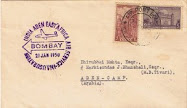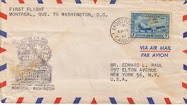Gabriel and Charles Voisin
Gabriel and Charles Voisin were among Europe's leading pioneer aviators.
Gabriel began his formal aviation career in 1903 when he was engaged by
a prominent French aeronautical promoter, Ernest Archdeacon, to build
gliders for him.
In 1905 Gabriel formed the first commercial aircraft manufacturing
company in Europe with the soon-to-be famous Louis Blériot. Numerous
disputes arose between the two quickly, resulting in Voisin buying out
Blériot's interest in 1906.
Gabriel immediately reformed the company with his brother Charles,
establishing the highly successful Appareils d'Aviation Les Frères
Voisin. The firm's first truly successful airplane appeared in 1907. The
classic Voisin pusher biplane design of 1907 was one of the most
significant aircraft of the pre-World War I era. Many of Europe's
leading aviators flew the Voisin.
Stamp issued by Comoro Islands showing portrait of the brothers Voisin and the Voisin biplane.
The Voisin biplane won accolades when Henri Farman made the first one-kilometer circuit in Europe in it, winning a 50,000-franc prize. By 1912, the Voisin brothers had produced more than 75 airplanes that were based on the simple and sturdy 1907 design.
In 1912, the Voisin brothers developed a version of their successful design for the military. Thereafter Compagnie Gabriel Voisin built aircraft almost exclusively for military contracts.
During the war, the Voisin pusher series performed a variety of
missions, including reconnaissance, artillery spotting, training, day
and night bombing, and ground attack. The Voisin Type 3 is also notable in having equipped the first dedicated bomber units. But by 1916 the Voisin Type 3 and its immediate successors became vulnerable to new, better performing, German fighters.
The Voisins were slow and with their pusher configuration they were
defenseless from the rear. Despite these limitations, these rugged and
reliable aircraft still had a role to play. Voisins were used as
trainers and for night missions for the remainder of the war. Voisin
pusher aircraft were supplied to, or built under license by, twelve
countries, including Britain, Russia, Italy, and the United States.





















